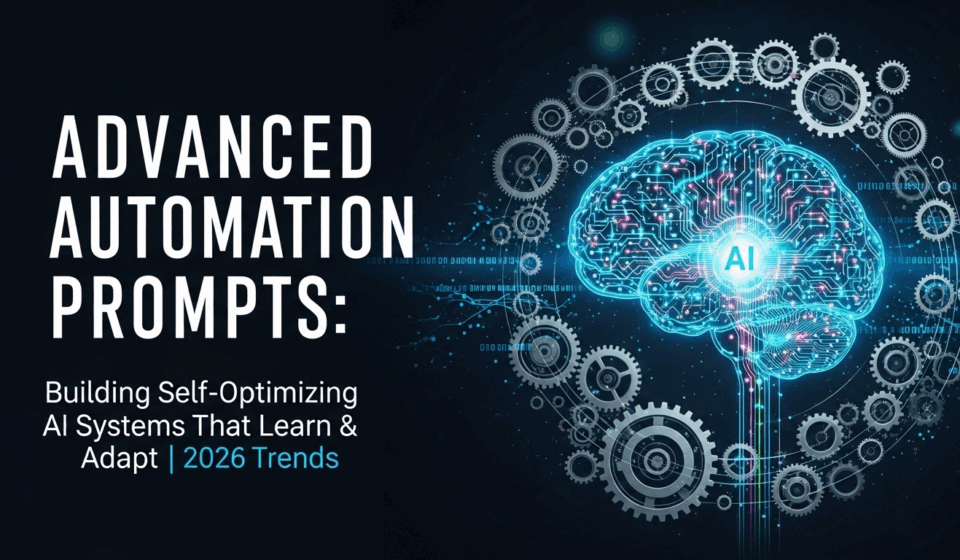
Advanced Automation Prompts: Building Self-Optimizing AI Systems That Learn & Adapt | 2025 Trends
Advanced Automation Prompts: Building Self-Optimizing AI Systems That Learn & Adapt | 2025 Trends
While most creators use automation to complete tasks, advanced automation prompts build systems that improve themselves. In 2025, the most successful automation implementations are dynamic, learning algorithms that adapt based on performance data.
Table Of Content
Advanced automation prompts incorporate feedback loops, machine learning principles, and decision trees making real-time adjustments.

Prompt #1: Predictive Content Performance Automation
Prompt:
“Build a predictive system that forecasts post performance before publishing. System workflow: (1) Analyze past 6 months of content data: which topics, formats, posting times generate highest engagement by platform. (2) Build a prediction model: given a specific post (topic, format, posting time, hook style), forecast predicted engagement level (low/medium/high). (3) When I draft new content, automatically score it on: hook strength, visual appeal, CTA specificity, topic relevance to trending interests. (4) For each post, recommend 3 posting time variations ranked by predicted engagement. (5) If predicted engagement is below historical average, auto-suggest optimizations. (6) Post the piece, then compare actual vs. predicted engagement to continuously improve accuracy. (7) Create weekly optimization reports showing prediction accuracy and recommended adjustments.”
Predictive automation lets you catch underperformers before they go live. Instead of guessing and learning from failures, you’re learning from predictions.
Prompt #2: Intelligent Budget Allocation Automation
Prompt:
“Create a financial automation that optimally distributes limited resources for maximum ROI. System: (1) Track every content piece: hours invested, money spent promoting, engagement generated, revenue attributable. (2) Calculate true ROI: engagement per hour invested, revenue per dollar spent, conversion by content type. (3) Identify ‘winner’ content (top 10% ROI) and ‘loser’ content (bottom 20%). (4) For winners, recommend increased investment. (5) For losers, recommend: archive, redesign, or deprioritize. (6) Automatically allocate next month’s budget based on performance: 60% to proven winners, 30% to optimized variations, 10% to experimental new angles. (7) Monitor in real-time: if a piece unexpectedly goes viral, dynamically increase promotion investment mid-campaign. (8) Generate weekly allocation reports showing optimal spending pattern.”
Smart automation routes resources to proven winners, creating compound advantage that accelerates growth exponentially.
Prompt #3: Emotional Resonance Automation
Prompt:
“Build an emotion-tracking system that monitors audience sentiment across all platforms. System: (1) Analyze comments, DMs, replies for emotional tone: inspired, informed, entertained, confused, frustrated, connected. (2) Create an emotion profile: which posts trigger which emotions consistently? (3) Track correlation: do certain emotions correlate with higher sharing or conversions? (4) Generate content recommendations based on optimal emotions. (5) Monitor for negative sentiment spikes: if frustration increases, auto-flag potentially confusing content. (6) Create a mood dashboard: real-time emotional temperature of audience response. (7) Build a ‘resonance map’: content angles, language choices, and story structures generating each emotion reliably. (8) Use learnings to optimize future content: increase emotional resonance angles that generate sharing.”
Prompt #4: Cross-Platform Audience Intelligence Automation
Prompt:
“Create a unified audience intelligence system across all platforms. System: (1) Track individual audience members across platforms when possible. (2) Build audience segments: superfans, engaged followers, passive followers. (3) Analyze segment behavior: what content does each segment prefer? What posting times do they check? (4) Personalize content per segment: create variations optimized for each group’s preferences. (5) Route communications strategically: DMs to superfans, public posts to passive followers. (6) Predict churn: identify followers showing declining engagement. (7) Generate segment expansion strategy: target similar audiences with messaging that worked. (8) Weekly reports: segment growth, engagement trends, churn prevention success rate.”
“The systems that win aren’t the ones that work hardest—they’re the ones that learn fastest.” — Systems Design Principle, 2025
Advanced Automation Success Framework
- Include measurement infrastructure: Build tracking and reporting into automation design
- Design adjustment loops: Include mechanisms for automation to adjust parameters based on performance
- Plan for anomalies: Build detection and alerting for unusual activity
- Create transparency: Understand why automation made each decision
- Test incrementally: Deploy advanced automation on small percentage first
- Maintain human oversight: Automation supports judgment, not replaces it
- Archive learnings: Document what automation discovers
Conclusion: From Execution to Orchestration
Advanced automation prompts represent the frontier of creator economics. You’re not just automating what you do—you’re automating how you think about and improve what you do. Systems that continuously learn compound advantages over time.
Tags: advanced automation, self-optimizing AI, machine learning, system design, optimization, AI orchestration






